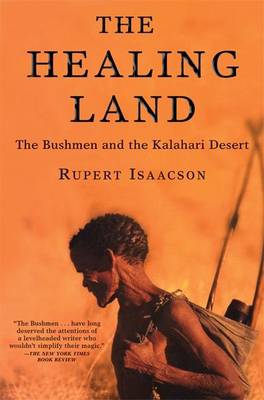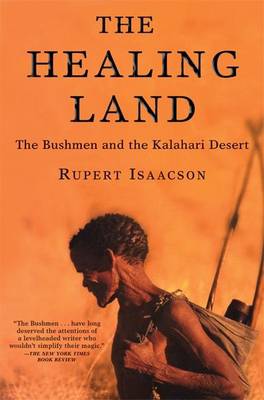
Bedankt voor het vertrouwen het afgelopen jaar! Om jou te bedanken bieden we GRATIS verzending (in België) aan op alles gedurende de hele maand januari.
- Afhalen na 1 uur in een winkel met voorraad
- Gratis thuislevering in België
- Ruim aanbod met 7 miljoen producten
Bedankt voor het vertrouwen het afgelopen jaar! Om jou te bedanken bieden we GRATIS verzending (in België) aan op alles gedurende de hele maand januari.
- Afhalen na 1 uur in een winkel met voorraad
- Gratis thuislevering in België
- Ruim aanbod met 7 miljoen producten
Zoeken
€ 18,45
+ 36 punten
Uitvoering
Omschrijving
Acclaimed by Rian Malan as "full of mystery, magic and strange coincidence," The Healing Land is a moving account of a remarkable personal journey through the Kalahari desert. Although brought up in "grey, drearily ordinary" London, Rupert Isaacson's links to Africa have always been strong. His mother was once a South African and his father was raised in what was then Rhodesia. Isaacson senior fled to England with no regrets, but Polly, Rupert's mother kept her memories of Africa alive, and handed them on to her children via the Bushmen nursery stories and remembrances of her early life there. Thus, from an early age, Isaacson was fascinated: "Long before I ever went to southern Africa, its names and regions had been described to me so many times that I could picture them in my mind's eye." Isaacson's relatives, mostly his grandfather Robbie, a Rhodesian farmer, frequently visited with exotic gifts and stories in tow, leaving the little boy wide-eyed and curious to go to the land of his ancestors. At eight, Isaacson finally visited Robbie in Africa, and "found the place as seductively, intensely exciting as all the stories had led [him] to expect." He also witnessed the other, less pleasant side of Africa. The war for independence was still being fought, and his grandfather's farm was fenced in with barbed wire and guarded by armed men. This first visit, however, sealed his connection to the African continent, and from then on he considered himself part English, part African. His curiosity now knew no boundaries and by the time he was twenty he embarked on his first solo trip to Africa. This marks the de facto beginning of the book as Isaacson, now a grown man, finds himself restless at home in England, yearning to be united with the Kalahari which he has made central to his identity as a young man. He visits Botswana's capital Gaborone where he meets his cousin Frank Taylor, a rather atypical white African, living in an austere home where he moved with his family, quitting his prosperous farm in South Africa, in order to help Botswana's rural poor. Isaacson learns of the plight of the Bushmen. Due to an upsurge in cattle ranching, the territories traditionally used for hunting have been fenced off and the game the Bushmen relied upon has been prevented from following the rain thus dying in droves. Eager to go deeper into the desert and to experience the Kalahari, Issacson makes several trips to the area during the following few years but never really makes it into the heart of the desert, but explores the areas surrounding it, living on a farm in Zimbabwe, traveling in South Africa and learning of its Bushman heritage. There he becomes enmeshed in the civil strife of 1993, which immediately preceded the first free elections and the rise of Nelson Mandela. He comes to experience the resentment of the black population towards the whites: he is attacked, mugged, chased by a mob of angry South African youths, but somehow all these events never put into question his resolve to come back. Eighteen months later he is back with his girlfriend and a contract to write a guidebook to Zimbabwe, Botswana, and Namibia. They start off from the Namibian capital Windhoek and two days later encounter two Bushmen while camping under a great baobab tree. Greetings are exchanged and it turns out that one of the Bushmen works for an NGO helping the cause of the local population. He speaks perfect English and invites Isaacson to go hunting with him the next day. The couple is naturally thrilled, but when they show up early next morning in the Bushman village no one seems to be up. It takes quite a while for everyone to wake up (presumably from alcoholic stupor) but all is well, and they ultimately leave for the hunting ground. The experience is disappointing, as Benjamin and his friend Xau make several attempts to catch antelopes but fail rather miserably. On their way back to the village Isaacson once again learns of the Bushmen plight, this time first-hand, and the lack of interest by the government to resolve their claims. He decides to help and try to involve a London travel agency to package tours into the Kalahari from which the Bushmen would benefit financially. Meantime, he and his girlfriend become friends with most of the villagers, sharing stories and songs, buying trinkets, and in the end witnessing a full-blown tribal dance. After his move to the USA that same year, Isaacson comes across an issue of National Geographic which features a photograph of two Bushmen kneeling in the red sand of South Africa next to a ancient figure of their dying father. According to the caption, it turns out this is a picture of the dying Regopostaan, patriarch of South Africa's Xhomani Bushmen, the last remaining clan of traditionally living Bushmen in the country. They've been ejected from a National Park, which used to make up their traditional hunting grounds, and the park authorities are resisting the Bushman land claaaaaaim. After some research, Isaacson learns of the few South Africans who are trying to counter the government indifference and fight for the Bushmen rights. With the new Mandela government chances for the Bushmen winning the claim are better but still far from becoming a reality. Later that year, in October of 1997, Isaacson arrives to the Xhomani village with a filmmaker friend who wants to make a documentary about the land claim. They meet Dawid Kruiper, the leader of the tribe, and one of the Bushmen from the National Geographic photograph, as well as the entire tribe. (Regopostaan was the tribal elder and Dawid's father, and the other person in the picture, Dawid's brother.) After spending time with them, recording interviews with Dawid, observing their day-to-day life, Isaacson begins to understand the extent of the Bushmen disenfranchisement. They are hardly the idealized hunters from his mother's stories and seem to be at the bottom of the social hierarchy not only in South Africa, but in the entire Kalahari as well. Ruined by alcohol as well as by the indifference of the politicians to take up their cause, the traditionally living Bushmen have not only dwindled in number, but have been literally reduced to beggars having lost their land and their traditional means of subsistence, and with that their identity as a people has been profoundly threatened. Dawid, the tribal leader, was once a great healer but due to his bouts with alcohol he has lost his powers. Moved by what he witnesses, Isaacson is keen to find out the other side of the story, and hence decides to interview the officials at the National Park, which has become the bane of the Bushmen's existence. The interview only serves to prove the underlying racism and corruption of the Park management which was just a few years ago a "whites only" establishment. What complicates matters even further and very much endangers the success of the Bushmen claim, is another parallel claim to the same land by another black tribe called Miet. All throughout his travels and interactions with the Bushmen, Isaacson's narrative displays an unusual sense of humanity, warmth, and openness. It's precisely these qualities that distinguish The Healing Land, and allow Isaacson to bring out the truly extraordinary spiritual legacy of the Bushmen. Thus, both the reader and the narrator bear witness to some rather remarkable displays of the Bushmen healing techniques as well as a general sense of genuine magic. The themes of healing, of Isaacson's personal quest alongside the larger, political one involving the entire Bushmen population, come together in a poignant ending which features all of the leading personalities that inhabit this extraordinary book.
Specificaties
Betrokkenen
- Auteur(s):
- Uitgeverij:
Inhoud
- Aantal bladzijden:
- 278
- Taal:
- Engels
Eigenschappen
- Productcode (EAN):
- 9780802140517
- Verschijningsdatum:
- 24/02/2004
- Uitvoering:
- Paperback
- Formaat:
- Trade paperback (VS)
- Afmetingen:
- 140 mm x 210 mm
- Gewicht:
- 367 g

Alleen bij Standaard Boekhandel
+ 36 punten op je klantenkaart van Standaard Boekhandel
Beoordelingen
We publiceren alleen reviews die voldoen aan de voorwaarden voor reviews. Bekijk onze voorwaarden voor reviews.












